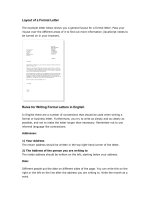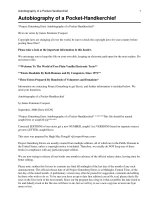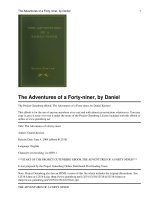Modelling of a nonlinear switched
Bạn đang xem bản rút gọn của tài liệu. Xem và tải ngay bản đầy đủ của tài liệu tại đây (267.05 KB, 6 trang )
MODELLING OF A NONLINEAR SWITCHED RELUCTANCE DRIVE BASED ON
ARTIFICIAL NEURAL NETWORKS
Ç. Elmas
*
, Ş. Sağıroğlu
+
, İ.Çolak
*
, G. Bal
*
*
Technical Education Faculty, Gazi University, Ankara, Turkey.
+
Engineering Faculty, Erciyes University, Kayseri, Turkey.
Abstract - Switched Reluctance Motors (SRMs) are
increasingly popular machines in electrical drives, whose
performances are directly related to their operating
condition. Their dynamic characteristics vary as condition
change. Recently, several methods of modelling of the
magnetic saturation of SRMs have been proposed.
However, the SRM is nonlinear and cannot be adequately
described by such models. Artificial Neural Networks
(ANNs) may be used to overcome this problem. This
paper presents a method which uses backpropagation
algorithm to handle one of the modelling problems in an
switched reluctance motor. The simulated waveforms of a
phase current are compared with those obtained from a
real switched reluctance commercial motor. Experimental
results have validated the applicability of the proposed
method.
INTRODUCTION
An important characteristic of the SRM drive is its
inherent nonlinearity. The inductance of the magnetic
circuit is a nonlinear function of both phase current and
rotor position. In addition, the system handles energy
most efficiently when the energy conversion cycles are
made as square as possible, maximising the ratio of
energy converted to energy input [12, 13]. This leads a
particularly difficult problem because of their complicated
magnetic circuit, which operates at varying levels of
saturation under operating conditions. Square energy
conversion cycles are created by driving the motor into
magnetic saturation and bring the energy handling
requirements of inverter into closer alignment with the
energy conversion characteristics of motor [12, 13]. This
can results in reduced switch requirements and energy
savings. The recirculated energy in a drive with an
applied voltage requires current flow and acts to increase
the inverter and motor losses that accompany the current
flow. Stephenson and Corda [1] proposed a quite
successful method to model the flux linkage as a function
of current and rotor position. This method has been
modified by several others [2, 3, 4]. Torrey and Lang [5]
have also proposed a method to provide analytical
expressions for the flux linkage and current for every
rotor position within a single summary equation. In
contrast to the above methods, there have been many
attempts to generate the necessary static magnetisation
curves by Finite Element Analysis (FEA) [6]. Recently,
the authors have reported an application of ANN for
modelling of the magnetic nonlinearity of the
magnetisation curves [14].
Artificial Neural Network (ANN) techniques have grown
rapidly in recent years. Extensive research has been
carried out on the application of artificial intelligence.
Artificial Neural Network technology has the potential to
accommodate an improved method of determining
nonlinear model which is complementary to conventional
techniques. NN are alone nonlinear and actual algorithmic
relevant set of training examples is required which can be
derived from operating plant data.
This paper investigates the use of ANNs for the modelling
of the magnetic nonlinearity of the SRM. Since this
method does not require any prior information regarding
the SRM system apart from the input and output signals, it
is quite simple and cost effective. The modelling method
in this paper departs significantly from previous
modelling method by the authors, in which the
magnetisation curves are represented by functions of flux
linkage against rotor position, rather than current. In the
paper, first, magnetic nonlinearity of the SRM is
presented, then ANN approach to the modelling of the
SRM is presented. ANN training requirements are
discussed next and finally, the models are verified through
comparisons with experimentally measured results.
MAGNETIC NONLINEARITIES OF THE SRM
The first step in modelling the nonlinearities of the SRM
is predicting (ψ/θ/i) curves for a given motor. For the
experimental motor, these curves are shown in Fig. 1.
Although the construction of the SRM is quite simple, it is
very difficult to derive a comprehensive mathematical
model for the behaviour of the machine. Many attempts
have been made by different researchers to overcome this
problem. The structure of Stephenson and Corda method
is that flux linkage is modelled as a function of current,
with rotor position as a parameter. This method is based
on storing the (ψ/θ/i) information in a look up table.
Elmas and Zelaya de la parra [4] described a similar
method which applies Least Squares curve fitting methods
to produce a representation of the measured magnetic data
as a series of polynomials. Pulle [3] has investigated the
merits of representing the magnetising curve of an SRM
by customised cubic splines and storing the coefficients in
a new data base with the aim of improving the method
suggested by Stephenson and Corda. Miller and McGilp
[1] have also adapted the Stephenson and Corda method.
Their aim was to represent flux linkage as a function of
rotor position, with current as an undetermined parameter
rather than position. In addition, an original work was
published by Torrey and Lang [5]. The goal of their
method was to provide complete analytic expressions of
the flux linkage current information for every rotor
position within a single summary equation.
The general equation of SRM for only one phase is as
follows:
VRi
d
dt
=+
ψθ(,)
i
(1)
For the solution of the Eq. (1), it is necessary to model
magnetic nonlinearities in the form of i(ψ,θ) rather than ψ
(i,θ) form as shown in Fig. 1. This is because after each
integration step the solution to Eq. 1 yields a value for the
flux which can be used to find the corresponding current
value for the next integration step. The variation of flux-
linkage with current is the same for the remaining phases
except for the angular dependence, which takes
1 A
2 A
3 A
4 A
5 A
6 A
Fig. 1 The variation of flux-linkage with current.
into account the physical interpolar spacing. The
experimental motor has a total of eight symmetrically
located stator poles used by a total of four phases (two
poles per phase).
NEURAL NETWORK MODELLING OF THE SRM
Ability and adaptability to learn, generalisation, less
information requirement, fast real-time operation and ease
of implementation have made ANNs popular in the last
few years. ANNs have been applied in many areas [7, 11].
Dynamic system modelling, identification and control
using ANNs are particularly very promising [7, 8, 10, 11].
As a result of that, the modelling of SRM has been
employed using the Backpropagation (BP) [9], which is
the most popular algorithm in the arena of neural
networks.
Backpropagation. The standard backpropagation by
Rumelhart and McClelland has been demonstrated on
various problems [7, 8, 9, 10, 11]. The reasons for using
this algorithm are that its structure is well understood and
its recent successful applications encourage the
applicants. This algorithm consists of a number of
propagation errors (PEs), a transfer function for each PE
in the layers, number of connections between layers (at
least three layers; an input, a hidden layer, an output
layer) and an algorithm or learning rule which is the
generalised delta rule.
This rule is simple and give a prescription for changing
the weights (w
ij
) in any feedforward network to map the
input-output pairs. This change is based on gradient
descent and relies on propagating an error occurred from
an output PE backwards, towards input layer through the
PEs in the hidden layers according to the errors. A simple
operation for calculating the output takes place when a set
of input is entered to the input layer. The calculation
direction is from input layer towards the output layer via
hidden layers.
The number of PEs in the input layer is equal to the
number of inputs in each input pattern, and each of these
PEs receives one of the inputs. The number of PE in the
output layer is the output of the network. The number of
PEs in the hidden layer depends on the discretion of the
network designer. However, there is no given clear
explanation implemented.
Fig. 2 shows the topology of NN with biases. Generally,
the weights between the layers are initialised with small
random values. This ensures that the networks train and
function easier. So it is important that the weights do not
start with the same value, thus nonsymmetric weights can
be obtained for internal representations. During training
the feedforward computation and the adjustment to the
weights based upon the error are determined. During
recall only the feedforward computation takes place as
mentioned earlier.
The algorithm is simple and relies on propagating an error
signal from the output layer backwards towards input
layer through hidden layers. The operation of calculating
the output takes place when the input signal is entered to
input layer. The calculation direction is from input layer
towards the output layer via hidden layers. The
feedforward computation and the weights' adjustments
based upon the error are determined during training. The
feedforward computation only takes place in recall.
+1 Bias
+1 Bias
O u t p u t s
Output Layer
Hidden Layer
Input Layer
More Layers
Weights
I n p u t s
Fig. 2. Topology of backpropagation neural network.
A simple training and recall chart is given in Fig. 3. It
shows the sequence of training and recalling procedure of
backpropagation. For some applications more than one
hidden layer are used.
Initialise weights randomly
Start training
Present input set to input layer
Calculate output throughout PEs
Adjusting weights
using gradient descent
Start testing
Present either training or testing
Set to input layer of network
An actual output from the network
error ?
set completed?
Stop
Calculating output throughtout PEs
not acceptable
acceptable
no
yes
Fig. 3 Training and recall flow chart of backpropagation
algorithm.
In the feedforward computation an input set passes onto
the hidden layer from input layer. The output of each PE
in the layer is calculated a weighted sum of its input, then
passes the sum through its activation function and
presents the activation value to the output layer. This
simply explains how a PE works. At this stage of training,
X represents the input vector, Position and Flux, and C
represents the desired output vector, Current. BP is briefly
reviewed here. If the network contains n inputs and m
outputs, X and C are given by:
(2)
Xfxxx x
Cfccc c
n
m
=
=
(, , , )
(, , , , )
123
123
If C
net
is the output vector of the neural network, the aim
of BP is to minimise the error values between the output
of the system (C) and the output of the network (C
net
).
This error is considered as a function of the connection
weights.
When the examples X and C are presented to the net, an
output of j-th PE in the kth layer is calculated as;
First, the inputs are multiplied by related weights and then
they are summed as;
(3)
net x
j
k
ji
i
n
i
=
=
∑
ω
0
)
Second, the output of the j-th PE in the k-th layer is
calculated as a function of net
j
as;
(4)
cf
netj
k
=
( net
j
where f is a transfer or threshold function. The transfer
function used in training of this work is given as follows;
fc
cT cT
cT cT
k
netj
netj netj
netj netj
()
exp( ) exp( )
(exp( ) exp( ))
=
+− − +
++ − +
(5)
where T is a threshold and
c
is the sum of the
weighted inputs for the j-th PE in the k-th layer. The
activation function is a 'smoothed' form of the threshold
function. The function used in the backpropagation
network should be monotonically increasing and
continuously differentiable such as hyperbolic tangent. It
should be noted that not all of the nets used the hyperbolic
tangent as given in Eq.(5). The input and output layer uses
linear activation function.
netj
The output obtained is used to feed the PEs in the further
layer as the inputs to it/them. This process continues till
reaching the output layer. When feedforward process has
completed, the backpropagating starts. A backpropagation
net learns by making changes in its weights in a direction
to minimise the error between the a desired value and its
prediction. The changes have been done using the steepest
decent or generalised delta rule. Assume that there are s
input/output pairs, x and c, available for training the
network. After presentation of a pair of s, the weights are
changed as follows:
(6)
ωω
ji
s
ji
s
ji
s() ( ) ()
=+
−1
∆ω
with
given by three equations when two hidden
layers are considered:
∆ω
ji
s()
hidden to output weights:
∆ω
ji
sk k
ij
k
netj
k
ji
sk
fnetcc
()() ( ) () () ( )()
()[ ]
=−+
−
η
1
−
α∆ω
1
)
−
1
∆ω
)
−−
12
∆ω
)
(7)
where j represents the number of PE in the output layer i
represents the number of PEs in the second hidden layer.
hidden to hidden weights:
∆ω
ji
sk k
i
k
ji
sk
f net error
()() ( ) () ()(
()
−− − −
=+
12 1 1
ηα
(8)
where;
error f net c c
kk
ji
k
neti
k
ij
sk
i
m
( ) ( ) () () ( )()
'()[ ]
−− −
=
=−
∑
11 1
1
ω
(9)
where i represents the number of PE in the output layer j
represents the number of PEs in the second hidden layer.
m is equal to the number of PEs in the output layer.
hidden to input weights:
∆ω
ji
sk k
j
k
i
m
ij
ks
i
s
ji
sk
f net error x
()() () ()()()() ()(
'()[
−− −
=
−
=
+
∑
22 1
1
1
ηωα
(10)
where i represents the number of PE in the second layer. j
represents the number of PEs in the first hidden layer. m
is equal to the number of PEs in the second layer.
where
: learning coefficient,
η
: momentum coefficient,
α
: delta weights from the i-th to the j-th
unit in the k-th layer
∆ω
ji
s()
: previous delta weights of the k-th
layer.
∆ω
ji
s(−1
After the first pair, the rest of the input set is applied to
the network. The weights of the network have been set of
randomised with a set of values which are distributed
uniformly between -0.1 and +0.1. The selected seed was
1.
Training and testing of neural network. The first and
usually longest step in this work was to collect data from
the system. The data set used in training was obtained
from the SRM machine experimentally. Obtaining
accurate data has taken an important place to train the
networks more accurately. Generally, this is the most
critical to prospective success. It must be possible to
gather an adequate sample of characteristics data so that
networks can learn efficiently, otherwise, it may be hard
or infeasible to train a neural network.
During training a reasonable strategy is to start with a few
hidden nodes and increase the number while monitoring
generalisation by testing at each epoch. The most common
index of generalisation for BP is mean squared error,
calculated by squaring each error, summing the squares,
then averaging the sum by number of outputs and data
patterns. A good technique for preventing overtraining is
to stop training when the improvement of the mean
squared error is stop. After a successful training the neural
network model is replaced with the SRM system. The
neural network is here a part of a larger application,
within which it acts like a callable function: the
application passes a set of input values to the neural
network model that the model produces phase current.
Backpropagation network used in modelling. The
backpropagation network used in modelling is shown in
Fig. 4 with a block diagram. This structure was used for
training and testing processes. After a couple of training,
it was found that two layers network achieved the
mapping task in high accuracy. The both learning and
momentum coefficients were 0.018 and the number of
epoch was 2000 for training. The most suitable network
configuration found was 2x8x8x1.
Current
Position(s)
Flux(s)
(s)
Fig. 4. Modelling the SRM using Artificial neural
network.
Calculation methods. The analysis is now proceeds by
solving the characteristic differential equations for each
topological mode by using the more accurate model for (ψ
/θ/i) variations discussed above. Since four phases of the
SRM are identical to each other only one model for (ψ/θ
/i) is sufficient and is used for the other phases. Before
going deep into calculation methods, it is necessary to
explain the torque production mechanism for the SRM.
The torque produced by a switched reluctance motor is
proportional to the rate of change of coenergy as the rotor
moves from one rotor position to another. The most
general expression for instantaneous torque for one phase
is:
T
W
e
cons t
=
′
=
∂θ
∂θ
(, )
tan
i
i
(11)
150
where T
e
is torque, θ is rotor position and W' is the
coenergy which is
′
=
ζ
W
i
ψθ
(, )
i
0
d
i
(12)
50
The coenergy is a function of both rotor position and
excitation current and hence, when evaluating the partial
derivatives, it is necessary to keep the indicated variables
constant.
The method of calculation is as follows. Initially the
values for phase flux (ψ), operating phase pole position (θ
) and phase current (i) are given as zero for the operating
phase. Eq. (1) is now solved numerically using the Runge-
Kutta numerical integration method. This yields a new
value for ψ. The program now refers to the derived (ψ/θ/i)
NN algorithm to find values for the phase current (i).
Since the steady state conditions are assumed, the speed is
constant. As the time constant of the mechanical system is
much slower than the electrical time constant, the phase
current and the phase flux can be accepted as a constant
between two integration intervals. Since the speed is
constant at a given value, the rotor position (θ) can
replace time as the independent variable.
The whole process is then repeated for the new values of
θ and ψ. The accuracy of the results thus depends on the
modelling of the flux current linkage.
COMPARISON BETWEEN SIMULATION AND
EXPERIMENTAL RESULTS
To explore the effectiveness of this technique, both
computer simulation and practical experimental work
have been carried out. As indicated by Eqs. (11) and (12),
the torque produced is based solely on the flux
linkage/current relationship. This suggest that if the phase
current is predicted correctly then the torque is also
known. Thus, comparison between current waveforms
from simulation and experiment should give enough
evidence.
Fig. 5 shows the variation of flux-linkage with current
along with NN results. These results have also
demonstrated the strong potential of the NN applied to the
SRM. Fig. 6 illustrates simulation result and an actual
measurement obtained by a data acquisition board. As
seen from Fig. 6, there is generally good agreement
between simulation and experimental results.
Flux (mWb)
0
25
75
100
125
0
15
30
Position (degree)
NN results
Training data
Fig. 5 The variation of flux-linkage with current along
with NN results.
Simulation result
Experimental result
(a)
(b)
Simulation result
Experimental result
Fig. 6 Current waveforms from simulation and
experimental measurement, a) low speed, b) high speed.
RESULTS
Figs. 7-10 show simulation results for the SRM obtained
by the proposed method. The motor was excited by a split
DC source converter (SDCSC). The following values
were used for the simulations: a DC link voltage of 200V,
per phase resistance of 2.56Ω, input filter inductance of
240µH and two input filter capacitors of 1000µF (each).
current
torque
flux
Fig. 7 Phase current, flux and torque waveforms at 60
rad/s motor speed.
Fig. 8 Coenergy at 60 rad/s motor speed.
current
torque
flux
Fig. 9 Phase current, flux and torque waveforms at 120
rad/s motor speed.
Fig. 10 Coenergy at 120 rad/s motor speed.
CONCLUSIONS
Simulation results were verified through experimental
results and ANN model was proven to be reasonably
accurate. The advantages of the model developed here are
that no a priori knowledge is required (model or
equation), reduced mathematical complexity, and faster
operation after training. However, it should be
emphasised during the development, the collection of a
data set is critical that the network can learn efficiently.
The training period usually takes a long time.
REFERENCES
[1] Stephenson J. M. and Corda, J., 1979, Proc. IEE,
Vol. 126, No. 5.
[2] Miller T. J. E. and McGilp M., 1990, Proc. IEE,
Vol. 137, Pt B, No. 6.
[3] Pulle D. W. J., 1991, Proc IEE, Vol. 138, Pt. B, No.
6.
[4] Elmas, Ç
. and Zelaya de la Parra H., 1992,
PESC'92, Vol. 2
, 844 - 849.
[5] Torrey D. A. and Lang J.H., 1990, Proc IEE, Vol.
137, Pt. B, No. 5.
[6] Lindsay J.F., Armugam R. and Krishnan R., 1986,
Proc. IEE, Vol. 133
, Pt B, No. 6.
[7] Pham D. T. and Sarolu ., 1992, The First
Turkish Symposium on Artificial Intelligence and
Neural Networks. Ankara, Turkey.
[8] Narendra K. S. and Parthasarathy K., 1990, IEEE
Trans. on. Neural Networks, 1(1), 4-27.
[9] Rumelhart D. E. and McClelland J. L., 1986,
"Parallel Distributed Processing", Vol. 1, The MIT
press, Cambridge.
[10] Chen S., Billings S. A. and Grant P. M.,1990, Int. J.
Control, Vol. 51, No. 6, 230-241,.
[11] Maren, C. Harston, and Pap R., 1990, Handbook of
Neural Computing Applications, Academic Press,
London ISBN 0-12-471260-6.
[12] Miller T.J.A., 1990, IEEE Trans. on. Ind. appl.,
Vol. IA-21, No. 5.
[13] Stephenson M. and EL-Khazendar M.A., 1989,
Proc. IEE, Vol. 136, Pt. B, No. 1.
[14] Elmas
Ç.
Sağırolu Ş.,
Ç
olak
İ
. and Bal G., 1994,
MELECON'94, Part 2,
809-812.









